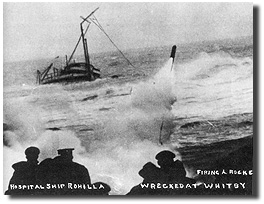FOR ALL THOSE WITH AN INTEREST IN BRITISH INDIA STEAM NAVIGATION (BI)
Book Review
THE 1914 ROHILLA DISASTER
Rohilla Centenary - special page
THERE are perhaps three events in British India's history that stand out in the imagination as disasters on the largest scale. Arguably the greatest of these was the sinking of the troopship Rohna in the Mediterranean in May 1940, an event which was to become the worst troopship loss for the US during the Second World War.
Twenty one years later, in peacetime, Dara succumbed outside Dubai to what was thought to be a bomb detonation. At least 212 people died in the explosion and the consequent fire, which gutted the ship. The third of these great BI casualties was the total loss of the 7,114 tons gross ship Rohilla in the early days of the First World War, not that this was a war loss in any but an indirect sense.
On the outbreak of war, Rohilla had been taken up as a naval hospital ship and was on passage south through the North Sea when at about 0400 on October 30, 1914 she ran aground just a mile south of the entrance to Whitby harbour on the northeast coast of England. The wind was gale force and under wartime restrictions, coastal lights had been extinguished. What ensued was one of the great rescue operations of the Royal National Lifeboat Institution.
In a new volume on the loss of Rohilla, local Whitby historian Colin Brittain describes how, in appalling conditions, the crews of several lifeboats set out to rescue the 229 people on board the stricken ship, which was already starting to break up. But for their efforts many more than the 84 who did lose their lives would probably have perished.
What makes the Rohilla incident so poignant are the accounts of the prolonged rescue attempt to save those still on board. It was 50 hours after the stranding that the last survivors were brought ashore in full view of the hundreds of townsfolk who came to watch the rescue from the beach and cliffs above the wreck, waving lanterns and cheering on the rescuers.
Mr Bittain's is not the first account of the loss but this book gives greater detail than hitherto of the rescue, which involved no fewer than six lifeboats and great feats of heroism, and to the inquests which followed Rohilla's loss. In fact, the book is more than anything the story of the efforts made by the lifeboat crews and others, resulting as they did in the award of four silver and three gold RNLI medals.
Rohilla and her sistership Rewa were the first in BI to be equipped with radio but, ironically, radio was not a significant factor in this incident, as the alarm was raised on shore almost as soon as the ship went aground. Indeed it was traditional signal lamps and rockets that played their part here.
Lessons from the sinking of Titanic two years previously had set in train improvements in ship safety and equipment. The Rohilla disaster was to have similar effect. The coroner had focused on the failure of the rocket brigade (right) to get a line successfully attached to the wreck from the Nab cliff. Had this been achieved early on, more people might conceivably have been saved.
In evidence to the Coroner's Inquiry, Rohilla's captain, David Landles Neilson, agreed with the coroner that it would be a good thing for ships to carry their own line-throwing rockets, and the jury concurred, recommending that passengerships in future be equipped with rocket apparatus. It is almost self-evident that in some circumstances it would be easier to launch a line successfully from a ship onto a broad shore, rather than trying to reach a relatively small target from the opposite direction. The recommendation was eventually acted upon with deepsea ships being required to carry appliances capable of throwing a line to a range of 250 yards.
As to the cause of the grounding, Captain Neilson was convinced Rohilla had hit a mine as he believed his ship to be six or seven miles to seaward of the place she struck. This difference was never explained, says the book, but it is reasonably clear that the absence, because of war, of navigational aids and lights must have made navigation at that time extremely difficult. In the end the jury determined that the ship did strike something a little time before she grounded on the rock at Saltwick where she broke up, as well as clearing the master of all blame for her loss.
Almost 90 years after the incident, Colin Brittain has in this book put together an impressive amount of information - probably more than has been assembled in public at any time since the 1914 hearings at that small Court House in Whitby. By his own admission Rohilla holds a fascination for the author and he has done well to bring to life the drama and heroism of those long hours in which 145 people were hauled to safety.
Into the Maelstrom - The Wreck of HMHS Rohilla by Colin Brittain, illustrated by John Littleford and Sarah Turner. Published by Tempus Publishing, The Mill, Brimscombe Port, Stroud, Gloucestershire, GL5 2QG, UK. (ISBN 0 7524 2384 3) Super A5 softback, pp128 with many monochrome illlustrations and photographs. £12.99
Other history pages: Timeline | Companies | Routes | BI News | Mercantile Empire | BI/P&O Merger document | Gairsoppa & Mantola | Dara wreck | Rohilla disaster | Calabria | Abhona trials | E Africa Shipwrecks | Today in History

